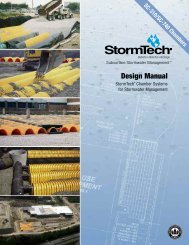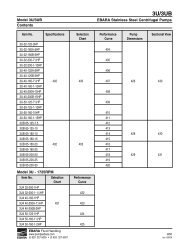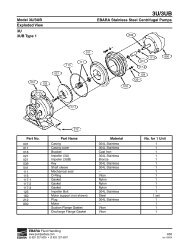Rodney Hunt - International Wastewater Technologies
Rodney Hunt - International Wastewater Technologies
Rodney Hunt - International Wastewater Technologies
You also want an ePaper? Increase the reach of your titles
YUMPU automatically turns print PDFs into web optimized ePapers that Google loves.
<strong>Rodney</strong> <strong>Hunt</strong><br />
A ZURN Company<br />
Rotovalve Cone Valve<br />
20 Questions
<strong>Rodney</strong> <strong>Hunt</strong><br />
Rotovalve Cone Valve<br />
20<br />
Questions<br />
1.<br />
2.<br />
3.<br />
4.<br />
5.<br />
6.<br />
7.<br />
8.<br />
9.<br />
10.<br />
11.<br />
12.<br />
13.<br />
14.<br />
15.<br />
16.<br />
17.<br />
18.<br />
19.<br />
20.<br />
What is a cone valve?<br />
How does the Rotovalve cone valve operate?<br />
What is the size availability for the Rotovalve?<br />
What are the standard materials of construction?<br />
Who makes the Rotovalve?<br />
What experience and services can <strong>Rodney</strong> <strong>Hunt</strong> Company<br />
offer someone specifying a cone valve?<br />
What are the chief differentiating features of the Rotovalve,<br />
and their benefit to the user?<br />
Where are Rotovalves used? What media can they handle?<br />
What control functions do they meet?<br />
What are the pressure, temperature, and velocity ranges for<br />
the Rotovalve?<br />
What is water hammer? How can the Rotovalve help control it?<br />
Why is the Rotovalve ideal for most "smaller than line size"<br />
applications?<br />
What does the, term "driptight” shutoff mean?<br />
What does the term "skirted” mean when used in reference to<br />
the Rotovalve? What are the advantages of the fully skirted<br />
Rotovalve?<br />
What is double seating? Is it necessary? Where are the two<br />
sets of seats?<br />
What kind of actuation equipment can <strong>Rodney</strong> <strong>Hunt</strong> company<br />
supply with a Rotovalve?<br />
What kind of valve actuation is the best?<br />
Does actuation equipment need to be mounted in any<br />
particular way?<br />
What accessories and special services are available?<br />
What maintenance is required (or recommended) for the<br />
Rotovalve?<br />
What spare parts should a user keep available?
1. What is a cone valve?<br />
A cone valve is a rugged<br />
and highly dependable liquid<br />
control valve which can<br />
accurately modulate flows<br />
under extreme velocity,<br />
pressure, and temperature.<br />
The cone valve is simple<br />
in basic configuration, and<br />
made up of three primary<br />
components (See Figure 1 ):<br />
1. Actuation Mechanism:<br />
Serves the function of lifting<br />
and rotating the plug in the<br />
body.<br />
2. Plug:<br />
Conically shaped<br />
element with a cylindrical<br />
bore (full pipe diameter).<br />
3. Body: Supporting<br />
member for the plug. The<br />
body enables connection to<br />
adjacent piping or<br />
equipment, and supports the<br />
head which provides a<br />
mounting surface for the<br />
mechanism.<br />
Indicator<br />
Rotator Lever<br />
Crosshead<br />
Lift Lever<br />
Lift Nut<br />
1. Mechanism<br />
2. Plug<br />
Plug and<br />
Body Bushings<br />
3. Body<br />
Monel Body Seats<br />
Roller<br />
Guide Rods<br />
Packing<br />
and Glands<br />
Head<br />
Shaft<br />
Plug and<br />
Body Bushings<br />
Figure 1
2. How does the<br />
cone valve operate?<br />
The Rotovalve cone valve is different from other<br />
through-ported valves (like the ball valve) in its unique<br />
seating/unseating operation.<br />
The plug is raised along the axis of the shaft to<br />
initiate opening of the valve, and lowered to complete<br />
closing of the valve (See Figure 3). This action permits<br />
the plug to rotate freely on journal bearings during the<br />
entire opening/closing sequence which reduces torque<br />
and eliminates seat wear.<br />
STEP 1. The closed position: The Rotovalve seats<br />
drip-tight with the machined Monel faces on both<br />
sides of the plug seating against the machined<br />
Monel surfaces on each side of the body.<br />
STEP 2. Lift actuation: The first movement of the<br />
actuator (manual, electric, or cylinder) moves the<br />
crosshead laterally toward the rotator lever. This<br />
initial lateral movement of the crosshead moves the<br />
lifter lever, which turns the lift nut and raises the plug<br />
away from the body seat. The plug has not turned.<br />
STEP 3. Opening: once the crosshead contacts the<br />
rotator lever, further lateral movement of the<br />
crosshead then turns the plug.<br />
STEP 4. Opening: Close-to-open, and open-to-close<br />
sequence can be adjusted for water hammer control.<br />
The two orifices of the valve (influent and effluent)<br />
drop the unbalanced pressure in two stages,<br />
reducing the potential for cavitation and vibration.<br />
STEP 5. Fully open: once the plug is fully rotated,<br />
continued movement of the crosshead turns the lift<br />
nut, reseating the plug.<br />
Actuator Mechanism Cross Section<br />
Mechanism Housing<br />
Crosshead<br />
Rotator Lever<br />
Lifter Lever<br />
Lifter Link<br />
Roller Guide Rod Figure 2 Figure 3
3. What is the size availability<br />
for the Rotovalve?<br />
Standard sizes from 6"-48" are normally cast or fabricated steel. The largest cone valve<br />
cast iron. Sizes 54" and larger are ductile iron, manufactured to date is 84".<br />
4. What are the standard materials<br />
of construction?<br />
Plug, Body, and Head. Generally, the plug, body, and head materials of the Rotovalve<br />
are specified as follows:<br />
0-150 psi Cast Iron<br />
150-250 psi Ductile Iron<br />
250-350 psi Cast Steel<br />
Special Applications. Valves for special applications, larger (over 54") dimensions, and<br />
higher pressures/temperatures are either cast or fabricated<br />
steel.<br />
Seats. Plug and body seats are Monel. Monel has the properties necessary<br />
to handle all known applications. Monel seats are welded<br />
to the body and plug, then both the body and plug seats are<br />
machined to effect drip-tight shutoff.<br />
Monel is a nickel/copper alloy. The high nickel content makes<br />
it the most corrosion resistant material that has all of the other<br />
characteristics required for this service. In comparison, stainless<br />
steel is a ferrous alloy, and not as corrosion resistant or weldable<br />
to cast iron.
5.<br />
Who makes the Rotovalve?<br />
Today, the Rotovalve cone valve is manu- Company acquired all product lines of AC<br />
factured by <strong>Rodney</strong> <strong>Hunt</strong> Company, based Valve, Inc., including the Rotovalve cone valve.<br />
upon designs and patterns acquired from The acquisition included inventory, patterns,<br />
AC Valve, Inc. The original design developed drawings, engineering documentation, and<br />
by S. Morgan Smith Company over 50 years sales records. This enables <strong>Rodney</strong> <strong>Hunt</strong><br />
ago was acquired by the Allis-Chalmers Company to supply parts and service as<br />
Corporation in 1959, and subsequently by required for all new and existing Rotovalves.<br />
AC Valve, Inc. (1988). In 1990, <strong>Rodney</strong> <strong>Hunt</strong><br />
6. What experience and services<br />
can <strong>Rodney</strong> <strong>Hunt</strong> Company offer someone<br />
specifying a cone valve?<br />
<strong>Rodney</strong> <strong>Hunt</strong> Company brings more than <strong>Hunt</strong> Company also has the ability to design<br />
150 years of engineering, manufacturing, and and manufacture complete hydraulic operating<br />
flow control experience to every project. In- systems for valve actuation and control,<br />
house design, manufacturing, and testing as well as providing field startup service if<br />
capabilities include a fully equipped foundry, needed.<br />
fabrication and machining facilities. <strong>Rodney</strong>
7. What are the chief differentiating<br />
features of the Rotovalve, and their<br />
benefit to the user?<br />
Feature Benefit<br />
Lift and Turn Operation 1 Low torque, no seat wear.<br />
Full Circular Waterway Opening 1 Lower pumping costs.<br />
1 Ability to pig.<br />
Rugged Construction, 1 Extremely low maintenance.<br />
Simple Design 1 Long life.<br />
1 Highly corrosion resistant seats.<br />
Precisely Machined Monel Body 1 Drip-tight shutoff.<br />
and Plug Seats 1 Long life.<br />
Fully Skirted 1 Reduces potential for cavitation and<br />
vibration.<br />
1 Eliminates areas that trap sediments.<br />
Hydraulic Characteristics 1 Precise flow control.<br />
1 Minimizes water hammer.<br />
Two Stage Pressure Reduction 1 Ability to handle wide pressure ranges.<br />
0 Excellent for throttling applications.
8.Where are Rotovalves used?<br />
What media can they handle?<br />
What control functions do they meet?<br />
Locations<br />
Media<br />
Functions<br />
Water Treatment and Transmission<br />
<strong>Wastewater</strong> Treatment<br />
Dams<br />
Steel Industry<br />
Process Plants<br />
Refineries<br />
Steam Power Plants<br />
Hydroelectric Power Plants<br />
Pump Stations<br />
Wind Tunnels<br />
Hydraulic Test Facilities<br />
Water<br />
<strong>Wastewater</strong><br />
Sludge and Slurry<br />
Air<br />
Gases<br />
Steam<br />
Oil<br />
Pump Check<br />
Stop Service<br />
Emergency Shutoff<br />
Pressure Regulation<br />
Level Regulation<br />
Pressure Modulation<br />
Velocity or Flow Modulation<br />
Turbine Control<br />
Vacuum Service<br />
Surge Control<br />
Energy Dissipation<br />
Smaller Than Line Size Service<br />
Where precise control is required especially under extreme<br />
conditions such as high velocity, high pressure, speed of<br />
closing, or frequent operation.
9.What are the pressure,<br />
temperature, and velocity ranges<br />
for the Rotovalve?<br />
Pressure<br />
Temperature<br />
Velocity<br />
"Standard" pressure classes can be summarized as follows:<br />
150 psi-cast iron<br />
250 psi-cast iron<br />
300 psi-cast steel<br />
There is virtually no pressure limitation for a custom engineered<br />
Rotovalve.10" valves have been designed and supplied to<br />
NASA that operate at 3,200 psi.<br />
Recommended temperature range is minus 30°F to steam applications.<br />
Special materials can be provided to meet specific<br />
applications.<br />
Essentially there is no maximum velocity. The Rotovalve can<br />
perform with long life in applications where the velocity is 50-100<br />
feet per second.<br />
10.What is water hammer?<br />
How can the Rotovalve help control it?<br />
Water hammer, a phenomenon occurring in 1 At the discharge side of a pump, when the<br />
pipe lines carrying incompressible fluids, is pump stops suddenly due to loss of power.<br />
attributed to a sudden change in the velocity E When a valve closes of those fluids. Such a<br />
change could be quickly.<br />
caused by the closing or opening of a valve, Every water hammer problem is different,<br />
which would cause a series of pressure and must be considered on a case-by-case<br />
"pulsations" in the line. These pulsations are basis. In most situations, slowing the speed of<br />
comparable to a bouncing spring, alternately valve closure will greatly reduce the dangers of<br />
compressing and decompressing. Unless water hammer.<br />
precautions are taken, the intensity of the first Because of the Rotovalve's ability to withwave<br />
(pulsation) can sometimes break the stand liquids moving at high velocities, and<br />
pipe. When designing a pipe line, the possi to precisely control valve opening/closing<br />
bility of water hammer should always be taken speeds, the Rotovalve is highly effective in<br />
into account. handling these potentially dangerous water<br />
Two of the primary causes of water hammer hammer conditions.<br />
are as follows:
11.Why is the Rotovalve ideal<br />
for most “smaller than line size”<br />
applications?<br />
The primary reason is that the Rotovalve is a<br />
full port valve, and when fully open provides full<br />
flow-through characteristics. When a Rotovalve is<br />
installed in a Venturi type arrangement ("smaller<br />
than line size"), head loss can be kept to a<br />
minimum.<br />
Another reason is that when a smaller valve is<br />
installed in a pipeline, higher velocities will result,<br />
allowing more precise flow control. In this<br />
situation, the Rotovalve has distinct performance<br />
advantages over other quarter-turn valves:<br />
The valve is fully skirted, eliminating sediment<br />
entrapment and ensuring that all flow passes<br />
through the port. Full skirting also reduces the<br />
potential for cavitation that can occur with<br />
other valves.<br />
Venturi Section Venturi Section<br />
Rotovalve<br />
Direction of flow<br />
The metal seating of the Rotovalve withstands<br />
high velocities, which may cause failure of<br />
resilient seats.<br />
There are two points of pressure reduction in<br />
the valve the inlet and the outlet orifices. This<br />
reduces the potential for vibration and<br />
cavitation and results in more precise control.<br />
“Smaller than line size" installations provide<br />
cost savings to the user in permitting the use of a<br />
smaller (and less expensive) valve, as well as the<br />
potential for downsizing the entire facility.<br />
Figure 4





